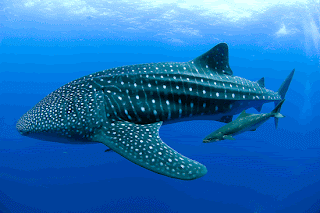The whale shark, Rhincodon typus, is a slow moving filter feeding shark and the largest fish species are still present. The largest confirmed individual has a length 12.65 meters (41.50 ft) and weigh more than 21.5 tonnes (47,000 lb), and there are unconfirmed reports of much larger whale shark. Individual claims of more than 14 meters (46 feet) and weigh at least 30 metric tons (66,000 pounds), which is not normal. The whale shark has many entries for slim size in the animal kingdom, especially far the largest non-mammalian vertebrates living, many dinosaurs biggest rival in weight. This is the only member of the genus Rhincodon and family, Rhincodontidae (pronounced Rhiniodon and Rhinodontidae before 1984), owned by the subclass Elasmobranchii in the class Chondrichthyes. Species originated about 60 million years ago.
The whale shark is found in tropical and warm oceans and lives in the open sea with around 70 years of age. Although whale sharks have very large mouths, as filter feeders they feed mainly, though not exclusively, on plankton, which are microscopic plants and animals. However, the BBC program Planet Earth filmed a whale shark feeding on a school of small fish. The same documentary film shows footage from the time of his arrival coincided with the whale sharks mass spawning shoal of fish and eat in cloud produced from eggs and sperm.
This species is distinguished in April 1828 after harpooning of 4.6 meters (15.1 ft) specimen in Table Bay, South Africa. Andrew Smith, a military doctor associated with British troops stationed in Cape Town, described it in the following year. The name "whale shark" comes from the physiology of fish, as large as the number of whale species and many species of filter feeders like whales.
Sea whale shark inhabits all tropical and warm-warm. Primarily pelagic, seasonal feeding aggregation occurs in some coastal areas such as the southern and eastern parts of South Africa; Gladden Spit in Belize, Ningaloo Reef in Western Australia; great Rann of Kutch in India, Utila in Honduras, Southern Leyte. Donsol, Pasacao and Batangas in the Philippines, off Isla Mujeres and Isla Holbox in the Yucatan, Mexico, National Park Ujung Kulon in Malaysia, Nosy Be in Madagascar Off Tofo Reef near Inhambane in Mozambique, Tanzania and the islands of Mafia, Pemba, Zanzibar and, very rarely, Eilat, Israel and Aqaba, Jordan. Although typically seen offshore, have been found closer to land, entering lagoons or coral atolls, and near the mouth of the estuary and river. Coverage is generally restricted to about ± 30 ° latitude. It is capable of diving to depths of 1,286 meters minimum (4,219 ft), [6] and migrate. On 7 February 2012, the huge whale shark found floating 150 kilometers (93 miles) off the coast of Karachi, Pakistan. Length of the specimen is said between 11 and 12 meters (36 feet and 39), weighing around 7,000 kg (15,000 lb).
In 2011 the largest aggregation of whale sharks ever recorded reported from Mexico's Yucatan coast, where more than 400 animals together in one place to feed on the seeds of small skipjack, Euthynnus alletteratus.
As a filter feeder has a wide mouth that can reach 1.5 meters (4.9 feet) wide and contains 10 filter pads and between 300 and 350 rows of tiny teeth. It has five large pairs of gills. Two small eyes are located at the front of the shark head wide, flat. Most body gray with a white belly, protruding buttocks conducted three along each side of the animal and the skin is marked with boxes pale yellow spots and underlined. The spots are unique to each individual and are useful for counting populations. Her skin can reach 10 centimeters (3.9 in) thick. The shark has a pair each of dorsal and pectoral fins. Teen Tails' has a larger upper than lower fin while the adult tail into semi-semi moon (crescent shaped). Spirakel just behind the eye.
The whale shark is the largest Cetacea non-animal in the world. The average size of adult whale shark estimated to be 9.7 meters (31.82 ft) and 9 tonnes (20,000 lb). Largest verified specimen was arrested on the 11th of November, 1947, near Baba Island, in Karachi, Pakistan. Was 12.65 meters (41.50 feet) long, weighed more than 21.5 tonnes (47,000 lb), and has a thickness of 7 meters (23.0 feet). Stories are much larger specimens - collected from 18 meters long (59 ft) and 45.5 tonnes (100,000 lb) are not uncommon in the popular shark literature - but no scientific records support their existence. In 1868 the Irish natural scientist Edward Perceval Wright obtained several small whale shark specimens in the Seychelles, but claimed to have seen specimens of more than 15 meters (49.2 feet), and talks about the reports of specimens over 21 meters (68.9 feet) .
In a 1925 publication, Hugh M. Smith describes a large animal stuck in bamboo fish trap in Thailand in 1919. Shark was too heavy to pull ashore, but Smith estimated that the shark was at least 17 meters (56 feet) long, and weighs about 37 tons (82,000 pounds). These measurements have been exaggerated to 43 tonnes (95,000 lb) and more precisely 17.98 meters (58.99 ft) in the last few years. A shark caught in 1994 from Tainan County, southern Taiwan reportedly weighed 35.8 tonnes (79,000 pounds). There has even been claims of whale shark to 23 meters (75 ft) and 100 tonnes (220 000 GBP). In 1934 a ship named Maurguani find a whale shark in the Southern Pacific Ocean, in violation, and the shark consequently became stuck on the bow of the ship, should by 4.6 meters (15.1 feet) on one side and 12.2 meters (40.0 ft) on the other side. There is no reliable documentation available for this claim, and they will "fish story".


No comments:
Post a Comment